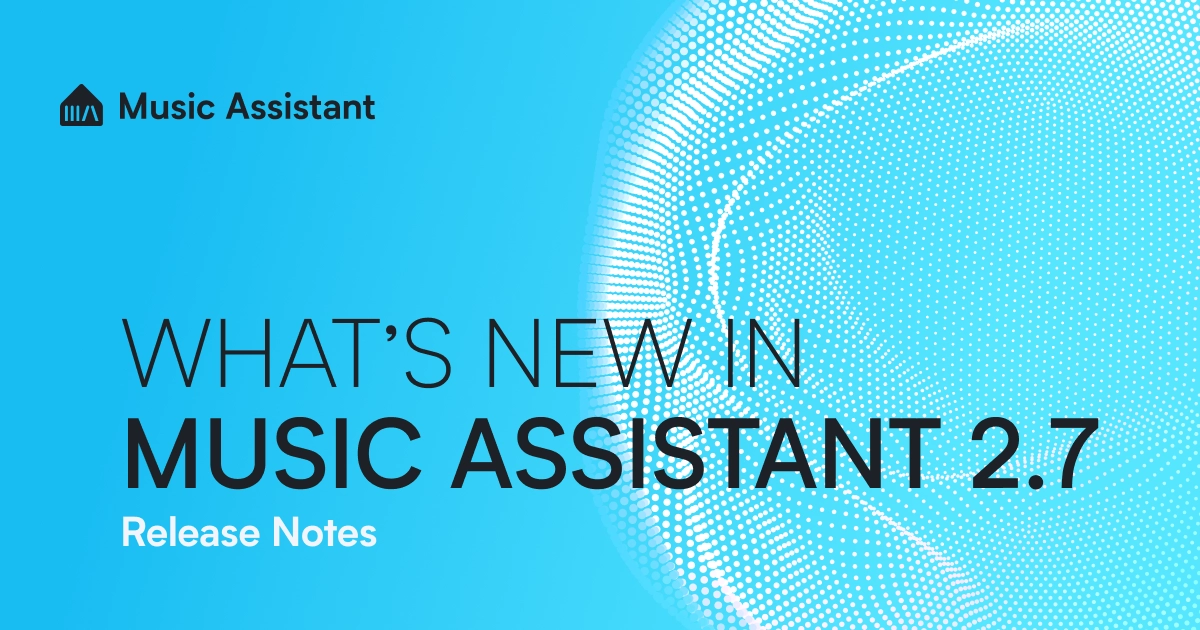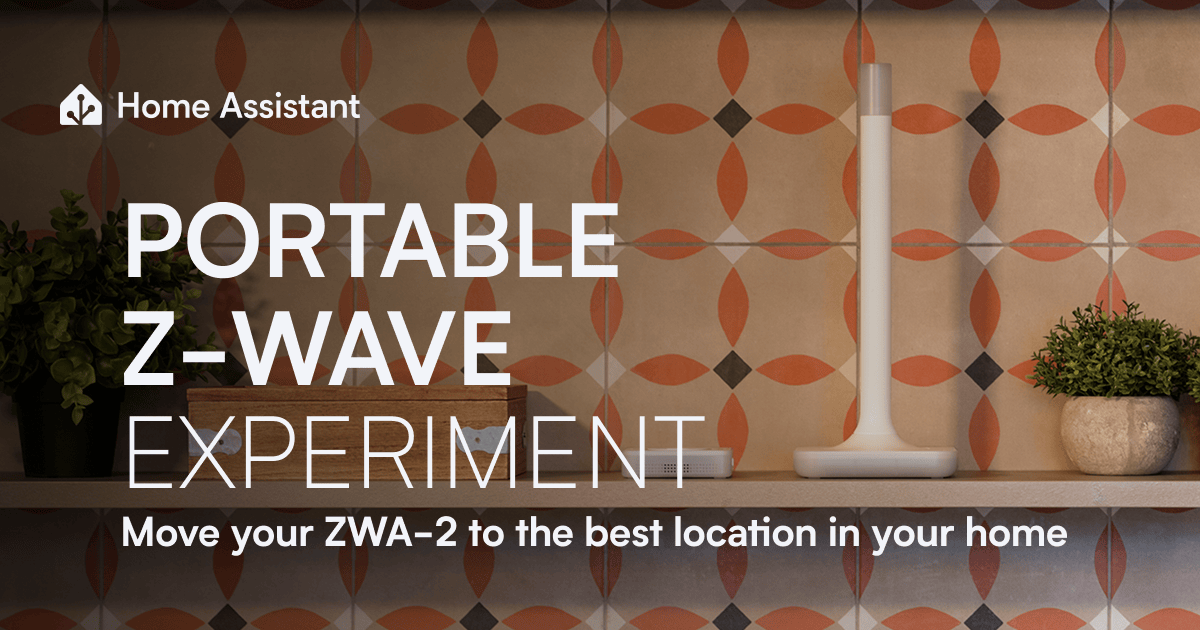Blog
Music Assistant 2.7 - Taking over the airwaves

It’s been a busy few months composing behind the scenes, building up to a massive crescendo. Today, the beat finally drops on Music Assistant’s
Of course, you can always update and experience all the great new stuff without reading the rest of this, but you might miss a deep cut. In fact, we can’t even cover everything in this blog (there really is that much), so go sing your praises for anything we missed in the comments!
Read on →More devices, more choice: celebrating a massive year for certification

If you’re ever in need of a device that works great with Home Assistant, well, I have just the program for you. Works with Home Assistant
Did you know that this year the Works with Home Assistant program has certified 12 partners across 12 months? That’s more than were certified in the two years since the program launched in 2022! The full list of devices is insanely long now (luckily, we made it searchable
2025.12: Triggering the holidays 🎄
Home Assistant 2025.12! 🎄
As the year winds down and the holidays approach, we’re closing out 2025 with a release that’s all about giving you more control and a little bit of magic. ✨
This month, we’re unveiling Home Assistant Labs, a brand-new space where you can preview features before they go mainstream. And what better way to kick it off than with Winter mode? ❄️ Enable it and watch snowflakes drift across your dashboard. It’s completely unnecessary, utterly delightful, and exactly the kind of thing we love to build. ❄️
But that’s just the beginning. We’ve been working on making automationsAutomations in Home Assistant allow you to automatically respond to things that happen in and around your home. [Learn more] more intuitive over the past releases, and this release finally delivers purpose-specific triggers and conditions. Instead of thinking in (numeric) states, you can now simply say “When a light turns on” or “If the climate is heating”. It’s automation building the way our mind works, as it should be. 🧠
Oh, and if you’re looking to level up your Zigbee or Thread network, check out the Home Assistant Connect ZBT-2 we released last month. It’s four times faster and has a gorgeous new antenna design that you’ll actually want to display on your desk. 📡
From all of us working on Home Assistant:
Thank you for an amazing 2025! ❤️
Happy holidays, and enjoy the release!
../Frenck
A little holiday cheer 🎄🎶
Jingle Labs by Frenck and Darren
Dashing through the code,
With a brand-new Labs to show,
Snowflakes start to fall,
Watch the dashboard glow!
Triggers now make sense,
Conditions feel just right,
What fun it is to automate,
Your smart home every night!
Chorus
Jingle Labs, jingle Labs,
Features on the way!
Oh what fun it is to run,
Home Assistant every day, hey!
Jingle Labs, jingle Labs,
Winter mode is here!
Turn your lights on with a thought,
And spread some holiday cheer!
Power graphs are live,
Water meters too,
Dashboards you can set,
For every user’s view!
Xbox got some love,
Shelly’s platinum now,
Contributors came through this year,
Take a final bow!
Chorus
Jingle Labs, jingle Labs,
Triggers for the win!
Climate, lights, and fans galore,
Let the automations spin!
Jingle Labs, jingle Labs,
Thank you all so much!
Happy holidays from us,
Now go and automate stuff!
The best gets better - Home Assistant Connect ZBT-2

The easiest way to start with Zigbee or Thread just got even better, with Home Assistant Connect ZBT-2. This USB adapter plugs into your Home Assistant system and opens up a world of smart device options. Between its precisely tuned antenna and next-generation chip, it’s a big step up for anyone looking to connect Zigbee, Thread, or Matter devices directly to Home Assistant.
For all our Zigbee fans, this might be the best upgrade you’ll make all year. We’ve squeezed every inch out of this technology, giving it the best range, speed, and stability possible. The same can be said for our Thread-heads out there (yeah, I just came up with that cool nickname 😎), making Matter or ESPHome Thread
If you’re one of those people still rocking three different hubs, what are you waiting for… another giant server outage to take down your smart home? Ditch those cloud hubs and take back your privacy today. As an added bonus, your devices will likely get more controls, range, and resilience.
Available today starting at $49 and €45 (that’s the MSRP, and pricing will vary by retailer). Designed and built by Nabu Casa and the Open Home Foundation, every purchase helps fund the development of Home Assistant. For quick specs, details, and where to buy, visit our beautiful Home Assistant Connect ZBT-2 page.
 Read on →
Read on →
2025.11: Pick, automate, and a slice of pie 🥧
Home Assistant 2025.11! 🎉
November is here, and we’ve been hard at work refining some of the main experiences that you interact with every day, and I think you’re going to love what we’ve built.
My personal favorite this release? The brand new target picker. 🎯
It’s one of those changes that seems simple on the surface, but makes such a huge difference in how you build automations. You can finally see exactly what you’re targeting, with full context about which device an entity belongs to and which area it’s in. No more guessing whether you’re controlling the right ceiling light when you have three of them!
But that’s just the beginning. We’re continuing with the automation editor improvements, this time with a completely redesigned dialog for adding triggers, conditions, and actions. It’s cleaner, easier to read, and sets the foundation for some really exciting stuff coming in future releases. 🤫
And speaking of making things clearer, you can now control exactly how entity names appear on your dashboard cards. Want to show just the entity name? The device name? The area? Or combine them? Even if you rename things, your dashboards will stay perfectly in sync. No more manual updates needed!
Oh, and energy dashboard fans will appreciate the new pie chart view for device energy, complete with totals displayed in the corner of every energy card. 🥧
Enjoy the release!
../Frenck
PS: Oh, and pssst… Don’t tell anyone 🤫, but there might be something exciting being released on November 19th. Hit the bell on this announced YouTube stream to not miss it
ELTAKO joins Works with Home Assistant

We’re delighted to welcome ELTAKO
You may never have seen one of ELTAKO’s little blue devices before, and that’s the point. They usually sit quietly behind walls, furniture and in distribution boards, doing their jobs without interfering with interiors. Now, thanks to their joining the Works with Home Assistant program, you can bring these professional-level installations to your own smart set-up.
Read on →Voice Chapter 11: multilingual assistants are here

Welcome to Voice Chapter 11 🎉, our long-running series where we share all the key developments in Open Voice. In this chapter, we will tell you how our assistant can now control more things in the home, in multiple languages at the same time, all while not talking your ear off. What’s more, our list of supported languages has grown again with several languages that big tech’s voice assistants won’t support. Join us for a deeper look at this voice chapter in our livestream
Ending production of Home Assistant Yellow

Today, we’re announcing that we will no longer be producing Home Assistant Yellow. Rest assured, it will continue to receive software support far into the future.
Read on →Connect ZWA-2 anywhere: Use Z-Wave over Wi-Fi or PoE

Last month, we launched the Home Assistant Connect ZWA-2, our take on the best possible Z-Wave adapter. Based
I’m Keith
During the launch, one piece of feedback we often received was that people wanted more flexibility in where they could place Connect ZWA-2 in their home — often far away from their Home Assistant system. It was no easy feat (more on that below), but we were able to build a solution that allows you to put it anywhere you have a network connection.
This experimental firmware will allow you to not only leverage the Wi-Fi chip inside the Connect ZWA-2, but also use it with other hardware to facilitate the use of the much-requested PoE. 🎉 This new firmware is only possible because of the second-generation platform we built Connect ZWA-2 on, which is open by design, allowing you to tinker and extend the device you own. Every piece of Home Assistant hardware reflects Nabu Casa and the foundation’s philosophy of constant evolution, and the software it launches with is just the beginning. Whenever we think of a cool new capability, we will work together to add it.
If you want to start using your Connect ZWA-2 with Portable Z-Wave today
Konnected joins Works with Home Assistant

Works with Home Assistant